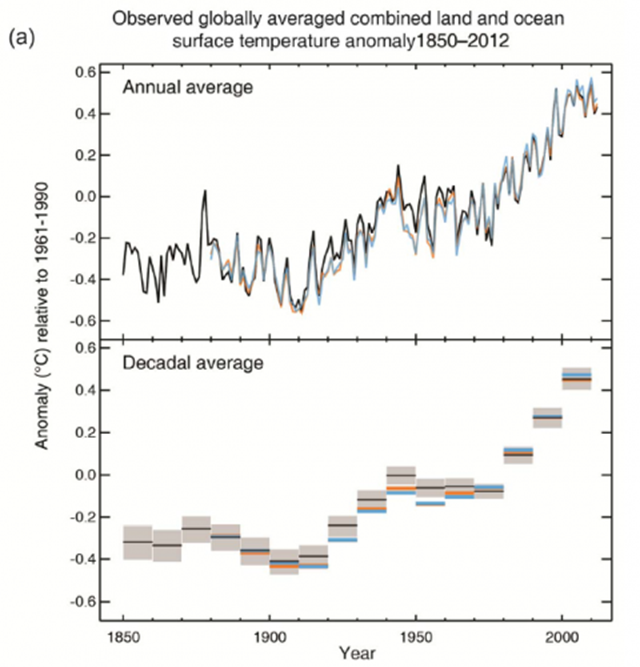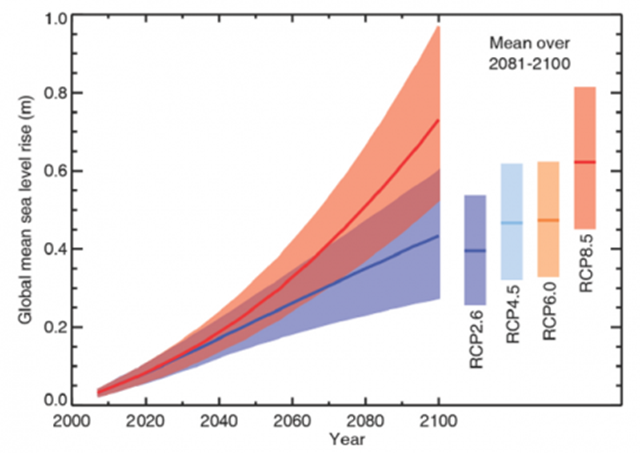Quick summary of new IPCC climate report: By 2100, Earth warms 4°C, sea level rises 28-98 cm, dry areas become drier, wet areas become wetter, summer Arctic sea ice disappears
By Stefan Rahmstorf
27 September 2013 (RealClimate) – The time has come: the new IPCC report is here! After several years of work by over 800 scientists from around the world, and after days of extensive discussion at the IPCC plenary meeting in Stockholm, the Summary for Policymakers was formally adopted at 5 o’clock this morning. Congratulations to all the colleagues who were there and worked night shifts. The full text of the report will be available online beginning of next week. RealClimate summarizes the key findings and shows the most interesting graphs.Global warming
It is now considered even more certain (> 95%) that human influence has been the dominant cause of the observed warming since the mid-20th century. Natural internal variability and natural external forcings (e.g., the sun) have contributed virtually nothing to the warming since 1950 – the share of these factors was narrowed down by IPCC to ± 0.1 degrees. The measured temperature evolution is shown in the [above] graph. Those who have these data before their eyes can recognise immediately how misguided the big media attention for the “wiggles” of the curves towards the end has been. Short-term variations like this have always existed, and they always will. These are mostly random, they are (at least so far) not predictable, and the IPCC has never claimed to be able to make predictions for short periods of 10-15 years, precisely because these are dominated by such natural variations. The last 30 years were probably the warmest since at least 1,400 years. This is a result from improved proxy data. In the 3rd IPCC report this could only be said about the last thousand years, in the 4th about the last 1,300 years. The future warming by 2100 – with comparable emission scenarios – is about the same as in the previous report. For the highest scenario, the best-estimate warming by 2100 is still 4 °C. […] What is new is that IPCC has also studied climate mitigation scenarios. The blue RCP2.6 is such a scenario with strong emissions reduction. With this scenario global warming can be stopped below 2° C. A large part of the warming will be irreversible: from the point where emissions have dropped to zero, global temperature will remain almost constant for centuries at the elevated level reached by that time. (This is why the climate problem in my opinion is a classic case for the precautionary principle.)
Sea-level rise
Sea levels are rising faster now than in the previous two millennia, and the rise will continue to accelerate – regardless of the emissions scenario, even with strong climate mitigation. (This is due to the inertia in the system.) The new IPCC scenarios to 2100 are shown the following graph.
This is perhaps the biggest change over the 4th IPCC report: a much more rapid sea-level rise is now projected (28-98 cm by 2100). This is more than 50% higher than the old projections (18-59 cm) when comparing the same emission scenarios and time periods. With unabated emissions (and not only for the highest scenario), the IPCC estimates that by the year 2300 global sea levels will rise by 1-3 meters. Already, there are likely more frequent storm surges as a result of sea level rise, and for the future this becomes very likely. [more]


In the title it says 1-3 meters by 2100, in the article it says by 2300
Thanks, corrected!
4C is not survivable. This has been well documented.
2C will destroy civilization. 4C will cause huge extinctions.
Exctinction is what this means, but we're still not being told the whole story.
At this point however, it makes no more sense to tell people the whole truth because it would simply create mass panic.
P.S. The IPCC report left out methane hydrates, on purpose. The report is NOT complete by a long shot.
This is NOT the place to get your true "status report" on what is happening to the planet. It is the politically expedient summary that was able to be published in this climate of denial, nothing more.
Many credible scientists have called for the disolution of the IPCC for this reason, claiming it is ineffective and literally years behind the actual science and measurements. I tend to agree having read the past 'assessments'. The worst-case scenarios are never accurate enough – we've blown right past ALL of them.
The new report is just as faulty, the predictions are far too mild and inaccurate, and absolutely critical data sets and effects were completely left out (be design, because they are too controversial, ie., "panic inducing").
~Survival Acres~